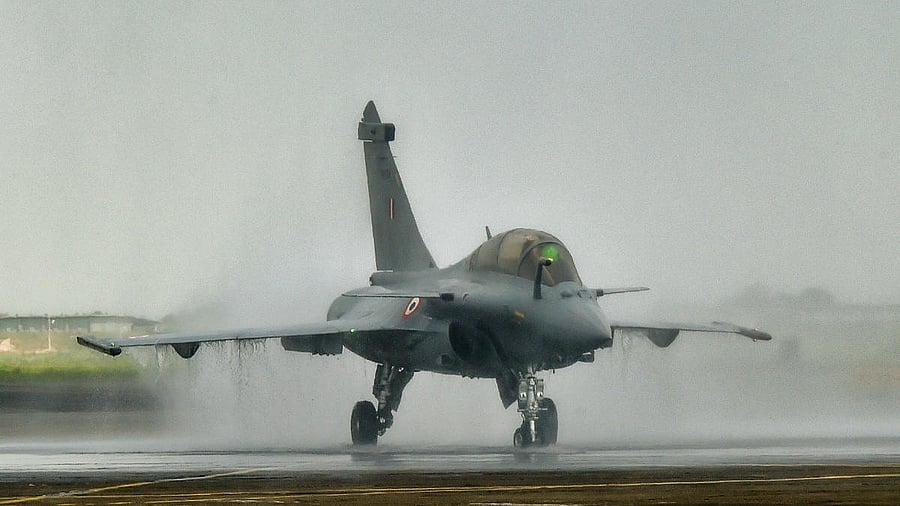
A Rafale aircraft
Credit: PTI Photo
In the face of an evolving global geopolitical space, superpowers are focusing heavily on improving the technology and capabilities of their respective air forces as aerial warfare grows more sophisticated.
Most major powers such as the USA, Russia and China are all focusing heavily on fifth generation fighter jets in order to gain a significant advantage in air power over rivals that do not possess the aforementioned aircraft. These jets possess significant advantages over previous gen fighters as listened in an article by Forbes. The impressive suite of new advancements in Beyond Visual Range (BVR) strike capabilities, stealth, advanced digital electronics and network-centric capabilities make them a formidable threat in aerial combat.
A recent opinion piece by Bloomberg outlines how India’s air force may be lagging behind in technology and may be ill equipped for potential future conflicts with hostile neighbours. The aging inventory in the form of older MIGs and Jaguars may become a significant drawback of the Indian Air Force.
The recent acquisition of the Dassault Rafale provides a boost to India’s aerial combat capabilities but despite that, these 4.5 gen fighter planes might only act as a stopgap solution as they lack stealth and data fusion technologies that other 5th range fighters have. As adversaries upgrade their fleets to include fifth gen fighters, India risks falling behind in the technological race unless it moves swiftly.
Rising regional tensions and fifth gen fighters
India’s strategic decisions are largely based on the developments along its borders with Pakistan and China. With China reportedly having deployed Chengdu J-20 "Mighty Dragon" stealth fighters along the borders near Sikkim, India faces a significant risk from its North-Eastern neighbour as the 5th Gen J-20 fighters have advanced stealth capabilities allowing it to potentially neutralise Indian radar and surface-to-air missile systems.
What is more concerning is Pakistan’s bid to acquire fifth generation fighter planes from China.
The reports of Pakistan approving the purchase of 40 Shenyang J-35 stealth fighters should be alarming for India, especially with tensions skyrocketing between the two nations after a terrorist attack, which India believes was orchestrated by Pakistan, in Pahalgam killing 26 tourists.
It is also important to note that the fifth generation aircraft being used by China and the ones that Pakistan is planning to buy are formidable tools of aerial warfare as they hold the capability of nearly going toe to toe with US-made fighters like the F-22 Raptor and the F-35 Lightning, according to a report by Economic Times.
Are Rafales enough?
The new Rafales purchased by India, despite being incredibly capable warplanes, might not hold out in the long run due to the increasing competitiveness of other fighters. While they provide an important upgrade over aging MiG-29s and SEPECAT Jaguars, they do not possess stealth, which is increasingly becoming a key component of survivability and lethality in modern aerial warfare. With enemy air defence systems growing more competent, stealth capabilities are becoming a dire need in order to provide a crucial advantage in first-strike capability and survivability. 4.5 Gen aircraft like the Rafale might be perfect for aerial combat as it stands now but it might quickly fall behind upcoming fifth gen fighters in contested battlegrounds. The very near future of aerial warfare will demand the low radar cross-section, advanced data fusion, and network-centric capabilities that only a true 5th generation fighter can offer.
India’s response: Building the AMCA
India has not been ignoring the threats posed by these developments, in fact, it is reportedly actively pursuing the development of an indigenously produced fifth gen fighter jet which has received the moniker Advanced Medium Combat Aircraft (AMCA). The fighter will potentially boast a plethora of advanced capabilities such as advanced avionics and sensors, data fusion capabilities and significant advancements in stealth. This makes it a bonafide fifth gen fighter.
In recent days, reports suggest that India has stepped up the development of the AMCA with a high-level committee now focused on developing a comprehensive strategy and a production-business model for the jet in light of Pakistan’s bid at acquiring fifth gen Chinese jets.
India has also explored the possibility of importing 5th generation fighters such as the Russian Su-57 and even the American F-35, but these moves may not prove to be feasible due to changing geopolitical alignments and concerns over technology transfer deals.
India’s pursuit of 5th generation fighters does not come from a place of ambition but rather it is driven by necessity. As China and Pakistan build and acquire advanced stealth fighters, India must ensure it does not cede aerial superiority in a region where air power could determine the outcome of future conflicts. The AMCA project represents both a strategic imperative and a symbol of India's aspiration to achieve defence self-reliance in the face of rising external threats.